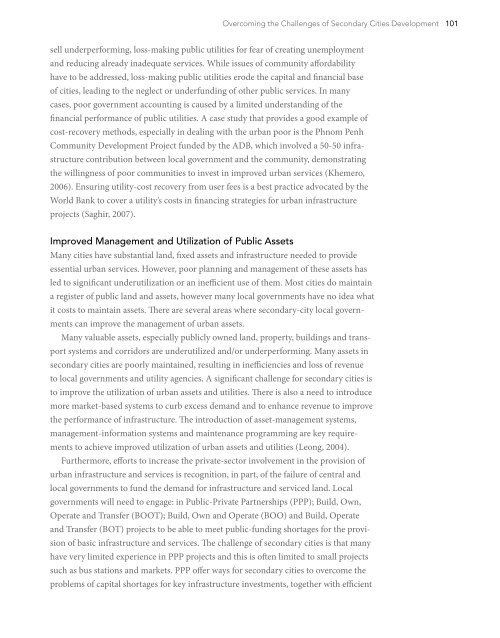DYhWN
DYhWN
DYhWN
You also want an ePaper? Increase the reach of your titles
YUMPU automatically turns print PDFs into web optimized ePapers that Google loves.
Overcoming the Challenges of Secondary Cities Development 101sell underperforming, loss-making public utilities for fear of creating unemploymentand reducing already inadequate services. While issues of community affordabilityhave to be addressed, loss-making public utilities erode the capital and financial baseof cities, leading to the neglect or underfunding of other public services. In manycases, poor government accounting is caused by a limited understanding of thefinancial performance of public utilities. A case study that provides a good example ofcost-recovery methods, especially in dealing with the urban poor is the Phnom PenhCommunity Development Project funded by the ADB, which involved a 50-50 infrastructurecontribution between local government and the community, demonstratingthe willingness of poor communities to invest in improved urban services (Khemero,2006). Ensuring utility-cost recovery from user fees is a best practice advocated by theWorld Bank to cover a utility’s costs in financing strategies for urban infrastructureprojects (Saghir, 2007).Improved Management and Utilization of Public AssetsMany cities have substantial land, fixed assets and infrastructure needed to provideessential urban services. However, poor planning and management of these assets hasled to significant underutilization or an inefficient use of them. Most cities do maintaina register of public land and assets, however many local governments have no idea whatit costs to maintain assets. There are several areas where secondary-city local governmentscan improve the management of urban assets.Many valuable assets, especially publicly owned land, property, buildings and transportsystems and corridors are underutilized and/or underperforming. Many assets insecondary cities are poorly maintained, resulting in inefficiencies and loss of revenueto local governments and utility agencies. A significant challenge for secondary cities isto improve the utilization of urban assets and utilities. There is also a need to introducemore market-based systems to curb excess demand and to enhance revenue to improvethe performance of infrastructure. The introduction of asset-management systems,management-information systems and maintenance programming are key requirementsto achieve improved utilization of urban assets and utilities (Leong, 2004).Furthermore, efforts to increase the private-sector involvement in the provision ofurban infrastructure and services is recognition, in part, of the failure of central andlocal governments to fund the demand for infrastructure and serviced land. Localgovernments will need to engage: in Public-Private Partnerships (PPP); Build, Own,Operate and Transfer (BOOT); Build, Own and Operate (BOO) and Build, Operateand Transfer (BOT) projects to be able to meet public-funding shortages for the provisionof basic infrastructure and services. The challenge of secondary cities is that manyhave very limited experience in PPP projects and this is often limited to small projectssuch as bus stations and markets. PPP offer ways for secondary cities to overcome theproblems of capital shortages for key infrastructure investments, together with efficient


